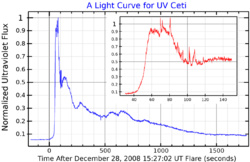Astronomy:Luyten 726-8
Coordinates: ![]() 01h 39m 01.54s, −17° 57′ 01.8″
01h 39m 01.54s, −17° 57′ 01.8″
Location of Luyten 726-8 in the constellation Cetus | |
| Observation data {{#ifeq:J2000.0|J2000.0 (ICRS)|Epoch J2000.0 Equinox J2000.0 (ICRS)| Epoch J2000.0 [[Astronomy:Equinox (celestial coordinates)|Equinox J2000.0}} | |
|---|---|
| Constellation | Cetus |
| Luyten 726-8 A (BL Ceti) | |
| Right ascension | 01h 39m 01.3773s[1] |
| Declination | –17° 57′ 02.587″[1] |
| Apparent magnitude (V) | 12.8[2] |
| Luyten 726-8 B (UV Ceti) | |
| Right ascension | 01h 39m 01.6377s[3] |
| Declination | –17° 57′ 01.001″[3] |
| Apparent magnitude (V) | 12.8[2] |
| Characteristics | |
| Luyten 726-8 A (BL Ceti) | |
| Spectral type | M5.5V[4] |
| U−B color index | 1.10 |
| B−V color index | 1.87 |
| Variable type | UV Cet[5] |
| Luyten 726-8 B (UV Ceti) | |
| Spectral type | M6 V[4] |
| Variable type | UV Cet[6] |
| Astrometry | |
| Luyten 726-8 A (BL Ceti) | |
| Radial velocity (Rv) | +29.0 km/s |
| Proper motion (μ) | RA: 3385.316[1] mas/yr Dec.: 544.386[1] mas/yr |
| Parallax (π) | 367.7119 ± 0.7418[1] mas |
| Distance | 8.87 ± 0.02 ly (2.720 ± 0.005 pc) |
| Absolute magnitude (MV) | 15.7[2] |
| Luyten 726-8 B (UV Ceti) | |
| Proper motion (μ) | RA: 3178.694[3] mas/yr Dec.: 584.061[3] mas/yr |
| Parallax (π) | 373.8443 ± 0.5009[3] mas |
| Distance | 8.72 ± 0.01 ly (2.675 ± 0.004 pc) |
| Absolute magnitude (MV) | 15.7[2] |
| Orbit[7] | |
| Companion | Luyten 726-8 B |
| Period (P) | 26.52 yr |
| Semi-major axis (a) | 1.95″ |
| Eccentricity (e) | 0.62 |
| Inclination (i) | 127.3° |
| Longitude of the node (Ω) | 150.5° |
| Periastron epoch (T) | 1971.91 |
| Argument of periastron (ω) (secondary) | 285.3° |
| Details | |
| Luyten 726-8 A | |
| Mass | 0.102 ± 0.010[8] M☉ |
| Radius | 0.14 R☉ |
| Luminosity | 0.00006 L☉ |
| Temperature | 2,670 K |
| Rotation | 0.2 days |
| Luyten 726-8 B | |
| Mass | 0.100 ± 0.010[8] M☉ |
| Radius | 0.14 R☉ |
| Luminosity | 0.00004 L☉ |
| Temperature | 2650 K |
| Other designations | |
| Luyten 726-8 A: BL Ceti, LHS 9 | |
| Luyten 726-8 B: UV Ceti, LHS 10 | |
| Database references | |
| SIMBAD | The system |
| A (BL Cet) | |
| B (UV Cet) | |
Luyten 726-8, also known as Gliese 65, is a binary star system that is one of Earth's nearest neighbors, at about 8.7 light years from Earth in the constellation Cetus. The two component stars are both flare stars with the variable star designations BL Ceti and UV Ceti.
Star system
The star system was discovered in 1948 by Willem Jacob Luyten in the course of compiling a catalog of stars of high proper motion; he noted its exceptionally high proper motion of 3.37 arc seconds annually and cataloged it as Luyten 726-8.[9] The two stars are of nearly equal brightness, with visual magnitudes of 12.7 and 13.2 as seen from Earth. They orbit one another every 26.5 years. The distance between the two stars varies from 2.1 to 8.8 astronomical units (310 to 1,320 Gm). The Luyten 726-8 system is approximately 2.63 parsecs (8.58 ly) from Earth's Solar System, in the constellation Cetus, and is thus the seventh-closest star system to Earth. Its own nearest neighbor is Tau Ceti, 0.98 pc (3.20 ly) away from it. If [math]\displaystyle{ R_v=+29 }[/math] km/s then approximately 28,700 years ago Luyten 726-8 was at its minimal distance of 2.21 pc (7.2 ly) from the Sun.[10]
Luyten-726-8A was later found to be a variable star and given the variable star designation BL Ceti.[5] It is a red dwarf of spectral type M5.5V. It is also a flare star, and classified as a UV Ceti variable type, but it is not nearly as remarkable or extreme in its behavior as its companion star UV Ceti.

Soon after[when?] the discovery of Luyten 726-8A, the companion star Luyten 726-8B was discovered. Like Luyten 726-8A, this star was also found to be variable and given the variable star designation UV Ceti.[6] Although UV Ceti was not the first flare star discovered, it is the most prominent example of such a star, so similar flare stars are now classified as UV Ceti type variable stars. This star goes through fairly extreme changes of brightness: for instance, in 1952, its brightness increased by 75 times in only 20 seconds. UV Ceti is a red dwarf of spectral type M6V.[4]
Both stars are listed as spectral standard stars for their respective classes, being considered typical examples of the classes.[4]
In approximately 31,500 years, Luyten 726-8 will have a close encounter with Epsilon Eridani at the minimal distance of about 0.93 ly. Luyten 726-8 can penetrate a conjectured Oort cloud about Epsilon Eridani, which may gravitationally perturb some long-period comets. The duration of mutual transit of two star systems within 1 ly from each other is about 4,600 years.[12]
Luyten 726-8 is a possible member of the Hyades Stream.[13]
See also
References
- ↑ 1.0 1.1 1.2 1.3 1.4 Vallenari, A. et al. (2022). "Gaia Data Release 3. Summary of the content and survey properties". Astronomy & Astrophysics. doi:10.1051/0004-6361/202243940 Gaia DR3 record for this source at VizieR.
- ↑ 2.0 2.1 2.2 2.3 Houdebine, Éric R.; Mullan, D. J.; Doyle, J. G.; de la Vieuville, Geoffroy; Butler, C. J.; Paletou, F. (2019). "The Mass-Activity Relationships in M and K Dwarfs. I. Stellar Parameters of Our Sample of M and K Dwarfs". The Astronomical Journal 158 (2): 56. doi:10.3847/1538-3881/ab23fe. Bibcode: 2019AJ....158...56H.
- ↑ 3.0 3.1 3.2 3.3 3.4 Vallenari, A. et al. (2022). "Gaia Data Release 3. Summary of the content and survey properties". Astronomy & Astrophysics. doi:10.1051/0004-6361/202243940 Gaia DR3 record for this source at VizieR.
- ↑ 4.0 4.1 4.2 4.3 Kirkpatrick, J. Davy; Henry, Todd J.; McCarthy, Donald W. Jr. (1991). "A standard stellar spectral sequence in the red/near-infrared - Classes K5 to M9". Astrophysical Journal Supplement 77: 417. doi:10.1086/191611. Bibcode: 1991ApJS...77..417K.
- ↑ 5.0 5.1 "Query= BL Cet". General Catalogue of Variable Stars. Centre de Données astronomiques de Strasbourg. http://www.sai.msu.su/gcvs/cgi-bin/search.cgi?search=BL+Cet.
- ↑ 6.0 6.1 "Query= UV Cet". General Catalogue of Variable Stars. Centre de Données astronomiques de Strasbourg. http://www.sai.msu.su/gcvs/cgi-bin/search.cgi?search=UV+Cet.
- ↑ Geyer, David W.; Harrington, Robert S.; Worley, Charles E. (June 1988), "Parallax, orbit, and mass of the visual binary L726-8", Astronomical Journal 95: 1841–1842, doi:10.1086/114781, Bibcode: 1988AJ.....95.1841G
- ↑ 8.0 8.1 Delfosse, Xavier et al. (December 2000), "Accurate masses of very low mass stars. IV. Improved mass-luminosity relations", Astronomy and Astrophysics 364: 217–224, Bibcode: 2000A&A...364..217D
- ↑ Luyten, W. J. (December 1949). "New stars with proper motions exceeding 0.5" annually.". The Astronomical Journal 55: 15. doi:10.1086/106322. Bibcode: 1949AJ.....55...15L.
- ↑ "Annotations on V* UV Cet object". Centre de Données astronomiques de Strasbourg. http://cdsannotations.u-strasbg.fr/annotations/simbadObject/1297613.
- ↑ Beskin, G.; Karpov, S.; Plokhotnichenko, V.; Stepanov, A.; Tsap, Yu. (January 2017). "Discovery of the subsecond linearly polarized spikes of synchrotron origin in the UV Ceti giant optical flare". Publications of the Astronomical Society of Australia 34. doi:10.1017/pasa.2017.3.
- ↑ Potemine, Igor Yu. (April 2010). "Transit of Luyten 726-8 within 1 ly from Epsilon Eridani". arXiv:1004.1557 [astro-ph.SR].
- ↑ Montes, D. et al. (2001). "Late-type members of young stellar kinematic groups - I. Single stars.". MNRAS 328 (1): 45–63. doi:10.1046/j.1365-8711.2001.04781.x. Bibcode: 2001MNRAS.328...45M. http://astrobib.u-strasbg.fr:2008/cgi-bin/cdsbib?2001MNRAS.328...45M. Retrieved 2010-04-18.
Notes
Further reading
- Durand, E.; Oberly, J. J.; Tousey, R. (1949). "Analysis of the First Rocket Ultraviolet Solar Spectra". The Astrophysical Journal 109: 1. doi:10.1086/145099. Bibcode: 1949ApJ...109....1D.
- Luyten, W. J. (1949). "New stars with proper motions exceeding 0.5" annually". The Astronomical Journal 55: 15. doi:10.1086/106322. Bibcode: 1949AJ.....55...15L.
External links



